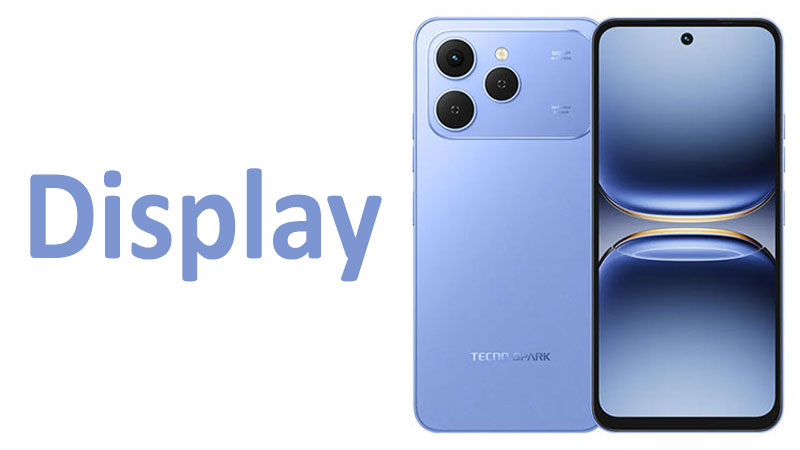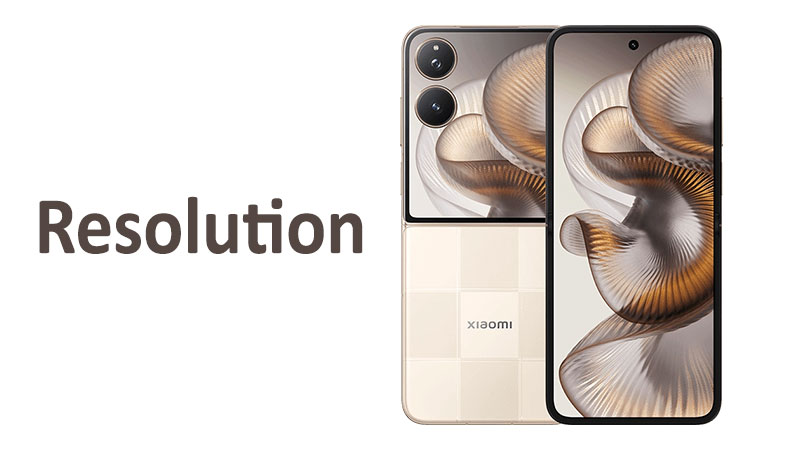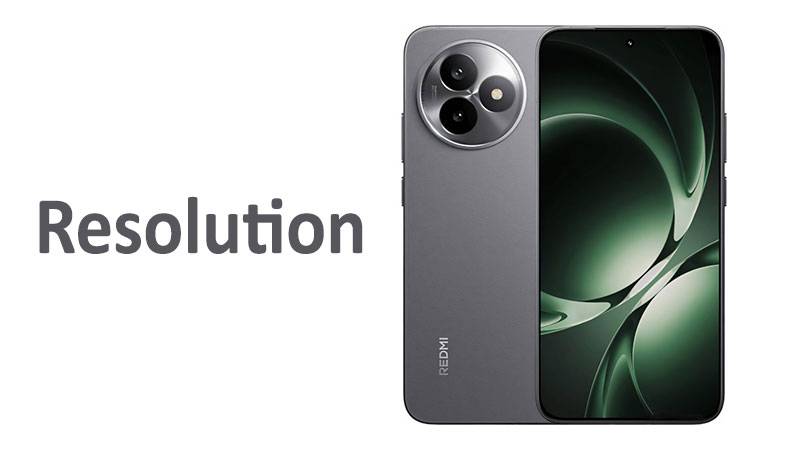The Tecno Spark 40 display sets a new benchmark for budget phone fluidity by integrating a super-fast 120Hz refresh rate into its large-screen format. Tecno targets the budget-conscious user who prioritizes ultra-smooth scrolling and responsive performance above all else. This detailed review examines every facet of the screen technology, from its IPS LCD panel to its HD+ resolution, helping you understand how these specifications translate into a real-world viewing experience. We will analyze the crucial trade-offs Tecno made to deliver this high refresh rate at an affordable price point. Understanding the combination of a 120Hz refresh rate and a 720p resolution is essential for any potential buyer considering the Tecno Spark 40.
Core Display Specifications Breakdown
The display is the window to your digital world. The Tecno Spark 40 features a set of specifications that are unique for its price category, notably the blend of high refresh rate and modest resolution. We examine the core technical data point by point to assess its visual impact.
The IPS LCD Technology Choice
Tecno chose an IPS LCD panel for the Spark 40. IPS stands for In-Plane Switching. This technology is widely used in many electronics, including budget smartphones and high-end monitors. IPS LCDs offer several benefits that make them ideal for this segment.
IPS panels provide excellent color accuracy and consistency, even when viewed at sharp angles. Colors do not shift or distort when you tilt the phone sideways. This characteristic ensures that multiple people viewing the screen simultaneously see the same image quality. IPS technology also typically provides a more natural color palette compared to the oversaturated look often found on some older AMOLED screens.
However, IPS LCDs rely on a backlight, which presents two limitations. First, black levels are not as deep as those achieved by AMOLED technology, where individual pixels can turn completely off. This means dark scenes in movies or games may look slightly gray instead of pure black. Second, the backlight affects power consumption. It must remain on to illuminate the entire display, which can drain the battery faster than an equivalent AMOLED screen in dark mode.
The 120Hz High Refresh Rate Advantage
One of the standout features of the Tecno Spark 40 display is its 120Hz refresh rate. This means the screen refreshes the image 120 times every second. This rate is double the old 60Hz standard and significantly higher than the common 90Hz found in many current budget phones.
The high refresh rate translates directly into an incredibly smooth user interface experience. Simple actions like scrolling through social media feeds, navigating the app drawer, or minimizing applications feel instantaneous and fluid. The reduction in motion blur is noticeable and provides a premium feel that often separates budget devices from more expensive mid-range and flagship models. This smoothness is a major selling point for the Spark 40.
For mobile gamers, the 120Hz rate is a substantial performance booster. It allows the display to keep up with high frame rate games, provided the internal chipset can handle the graphics rendering. A 120Hz panel ensures minimal input lag and maximum visual clarity during fast-paced action sequences. This feature makes the Spark 40 an attractive option for budget-minded mobile gaming enthusiasts.
Resolution Reality: HD+ (720p) Pixel Density Analysis
The Tecno Spark 40 features a resolution of 720 x 1600 pixels. This is commonly referred to as HD+ resolution. It results in a pixel density of approximately 263 pixels per inch (ppi). This resolution choice is the primary technical compromise Tecno made to include the 120Hz refresh rate while keeping the price low.
Pixel density dictates the sharpness of images and text. At 263 ppi, the individual pixels may be visible, especially to users with keen eyesight or when holding the phone very close to the face. Text edges might appear slightly softer than on a Full HD+ (1080p) display. This softness is the most likely area where users notice the phone’s budget nature.
However, for most general usage—watching standard YouTube videos, browsing photos, and everyday texting—the 720p resolution remains perfectly acceptable. The benefit of lower resolution is reduced strain on the processor and the battery. The GPU requires less power to render only 720p worth of pixels 120 times per second, which improves performance and battery efficiency, counteracting the extra battery consumption from the IPS backlight. Tecno prioritized speed and longevity over absolute maximum sharpness.
Size and Form Factor: 6.67 Inches of Screen Real Estate
The display size is 6.67 inches, which places the Spark 40 firmly in the large-screen smartphone category. This expansive size is excellent for productivity tasks and immersive media consumption. The large screen makes multitasking easier and significantly improves the viewing experience for movies and web browsing.
The screen-to-body ratio is specified at approximately 84.2%. This indicates relatively thin bezels surrounding the display, especially compared to older generation budget phones. The minimized border design allows the large screen size to fit comfortably within the device’s overall dimensions. The large, nearly edge-to-edge design enhances the modern aesthetic and immersive feel of the phone.
The display utilizes a 20:9 aspect ratio. This cinematic ratio is tall and narrow, making the phone comfortable to grip despite its overall size. It is perfectly suited for viewing cinematic content, as most modern movies are formatted in similar aspect ratios. This ratio also provides extra vertical space for viewing more lines of text or more items in a list without needing to scroll.
Real-World Performance and User Experience
Understanding the raw specifications is one thing; assessing how they feel during daily use is another. The combination of IPS LCD, 120Hz, and 720p resolution creates a unique experience that emphasizes speed and smoothness. The real-world performance centers on these interactions.
Scrolling, Animations, and Daily Fluidity
The 120Hz refresh rate is undoubtedly the most impactful feature on daily fluidity. Users notice the difference instantly when they scroll through any application. The smoothness makes the phone feel faster and more responsive than its processor might otherwise suggest. Navigating the operating system, switching between apps, and viewing long documents all benefit from the silky-smooth movement.
This high level of fluidity compensates significantly for the lower screen resolution. Many users prefer a fast, smooth experience over maximum sharpness, especially in the budget segment. Tecno made a strategic decision here, optimizing the device for interactive use rather than static image viewing. The overall UI experience is exceptionally pleasant and comparable to devices priced much higher.
Gaming Performance and Responsiveness
For mobile gamers, the Tecno Spark 40 offers a compelling package. The 120Hz display is crucial for competitive gaming. It provides the visual information faster than a 60Hz or 90Hz panel. This speed advantage can be critical in high-octane games where split-second reaction times matter.
The 720p resolution plays an interesting supporting role in gaming. Since the GPU only needs to render graphics at HD+ quality, it can maintain higher frame rates more consistently. This means popular games will run more smoothly and stably, avoiding the frame drops that plague some 1080p devices with similar processors. The trade-off is slightly reduced graphical fidelity, but better stability and responsiveness. The Spark 40 is optimized for competitive performance rather than ultra-high detail graphics.
Media Consumption and Visual Quality
Media consumption, including streaming video from platforms like YouTube and Netflix, provides a mixed experience. The 6.67-inch size creates a large, immersive canvas for movies and shows. The IPS LCD technology ensures good color representation and wide viewing angles, making it suitable for sharing content with friends.
However, most streaming services offer content up to 1080p resolution. The Spark 40’s 720p panel cannot display the full clarity of Full HD content. While the screen downscales the video, making it look decent, viewers who are used to 1080p displays will notice the difference in fine detail. Text and small objects in high-definition video appear softer. This is a crucial consideration for buyers whose primary use case is high-resolution video streaming.
The contrast ratio, a weakness of IPS technology, means that deep space scenes or dark cinematic sequences lack the profound depth of an AMOLED screen. The blacks appear lifted, resulting in a less dramatic visual experience. The high screen-to-body ratio partially offsets this by providing an engaging visual perimeter.
Outdoor Visibility and Brightness
A significant challenge for many budget-oriented LCD screens is achieving sufficient brightness for comfortable outdoor use. While Tecno typically optimizes its displays for high ambient lighting, the IPS LCD technology inherently struggles to compete with the sheer peak brightness of high-end AMOLED screens. Direct sunlight washes out the display, forcing users to shade the screen manually.
The Tecno Spark 40 needs a competitive peak brightness level, likely in the 500-600 nits range, which is standard for the class. This brightness is generally sufficient for indoor and overcast outdoor conditions. However, under bright, direct sunlight, the visibility decreases noticeably. Users who spend significant time outdoors should be aware of this common limitation of budget IPS panels. Finding an optimal viewing angle and keeping the screen clean becomes essential in bright environments.
Power Efficiency and Battery Impact
The display specifications have a complex relationship with battery life. The 120Hz refresh rate inherently consumes more power than a standard 60Hz rate because the screen updates twice as often. To mitigate this drain, Tecno often implements an adaptive refresh rate system, which automatically drops the rate to 60Hz when viewing static content, like a photo or a document.
The low 720p resolution offers a compensatory benefit. The lower pixel count requires less computational effort from the CPU and GPU, which saves power across the entire system. This balance ensures the Tecno Spark 40’s battery delivers respectable endurance despite the power-hungry 120Hz display setting. The battery life is generally optimized for a full day of moderate use by leveraging this resolution trade-off.
Display Comparison: Spark 40 vs. Competitors/Predecessors
The Tecno Spark 40’s display strategy involves a daring trade-off: sacrificing resolution for extreme smoothness. This sets it apart from both its predecessors and key market competitors. Analyzing these differences helps contextualize the Spark 40’s value proposition.
The Leap from the Tecno Spark 30
The most critical comparison is with its immediate predecessor, the standard Tecno Spark 30. The Spark 30 featured a 6.78-inch IPS LCD display with a 1080 x 2460 (Full HD+) resolution and a 90Hz refresh rate.
The Spark 40 represents a clear shift in priorities. It downgrades the resolution from 1080p (around 396 ppi) to 720p (around 263 ppi). This reduction in pixel density is a step backward for image clarity. However, the refresh rate moves up from 90Hz to a super-fluid 120Hz.
This means Tecno decided that motion quality and responsiveness were more important to the target budget audience than maximum static sharpness. Users migrating from the Spark 30 will experience a much smoother phone, but they will also notice the slightly softer text and images. This trade-off is a strategic pivot aiming for a better perceived speed in daily operation.
Competing with AMOLED Rivals in the Budget Segment
Many budget rivals today, particularly from brands like Samsung and Xiaomi, are pushing lower-cost devices that feature AMOLED screens, albeit usually limited to a 60Hz or 90Hz refresh rate. AMOLED panels provide infinite contrast, pure blacks, and generally higher color vibrancy.
The Tecno Spark 40 cannot compete with the visual punch of an AMOLED display. Its IPS screen has weaker contrast and less saturated colors. Where the Spark 40 wins is on pure speed. A 120Hz refresh rate delivers a visibly smoother scrolling and gaming experience than a 60Hz AMOLED phone. The choice here comes down to user preference: do you prioritize deep blacks and rich colors (AMOLED) or hyper-fluid motion (Spark 40’s 120Hz IPS)?
120Hz HD+ vs. 60Hz FHD+ Trade-Off
The core market competition often involves a 120Hz HD+ option versus a 60Hz FHD+ option at a similar price. The Spark 40 squarely champions the former.
A 60Hz Full HD+ display provides crystal-clear text and sharp image detail. This option is ideal for heavy readers, photo editors, or users who mostly watch high-resolution video content. However, the user interface will feel slower and choppier due to the lower refresh rate.
The Tecno Spark 40’s 120Hz HD+ setup provides a feeling of speed, performance, and modern technology. It excels for gamers and social media users who interact constantly with moving elements on the screen. The pixel density is the compromise. Ultimately, the Spark 40 is designed to appeal to those who value the perception of speed over maximum clarity, a key trend in the entry-level mobile market.
Critical Buying Guide: Pros, Cons, and Key Considerations
For any buyer interested in the Tecno Spark 40, understanding the screen’s advantages and disadvantages is crucial for managing expectations. This display offers some flagship-level features but retains distinct budget limitations.
Major Strengths (Pros)
The Tecno Spark 40 display offers several compelling advantages that make it stand out in its price range. The most significant benefit is the 120Hz high refresh rate. This feature ensures an incredibly smooth and responsive user interface, enhancing the daily experience dramatically. Scrolling, animations, and app switching feel fast and fluid.
Another strength is the large 6.67-inch display size. This ample screen real estate is ideal for multimedia consumption, split-screen multitasking, and mobile gaming, offering an immersive visual experience. The IPS LCD technology itself provides accurate and natural color reproduction. Colors are consistent and generally faithful to the source, even when viewed from extreme angles. The color temperature remains stable, avoiding the color shifts seen in older, cheaper display types.
Finally, the combination of 120Hz and 720p resolution is battery-friendly. The lower number of pixels rendered helps offset the power consumed by the high refresh rate, resulting in optimized battery life for a device with such fast screen technology.
Notable Limitations (Cons)
The display’s primary limitation is the 720 x 1600 pixel resolution. The resulting 263 ppi density means that text and fine details lack the sharpness of a 1080p display. Users who are accustomed to Full HD+ resolution will likely notice the softness in icons and text. This is the biggest hurdle for media enthusiasts.
As an IPS LCD panel, the display struggles with contrast compared to rival AMOLED technology. Black areas of the screen appear slightly gray rather than perfectly black. This affects the viewing experience in dark environments or when watching high-contrast media.
Outdoor visibility also poses a minor challenge. While likely adequate for typical use, the maximum brightness of the IPS LCD is insufficient to overcome bright, direct sunlight, leading to screen wash-out. Users must often seek shade to view the screen comfortably outdoors.
Essential Takeaways for Potential Buyers
Potential buyers of the Tecno Spark 40 need to embrace the core compromise of the device. You are buying a phone that prioritizes speed and fluidity over absolute visual clarity.
If you are a mobile gamer, a heavy social media user, or someone who simply values a fast-feeling, responsive phone, the 120Hz refresh rate will be a huge positive. The smoothness elevates the user experience beyond most phones in this category.
If your main usage involves reading long articles, watching high-definition video content, or doing any detailed image viewing, the 720p resolution may disappoint you. In that case, you might consider a rival phone with a 60Hz or 90Hz Full HD+ AMOLED screen. The Spark 40 is a niche offering for the speed enthusiast on a budget. Understand that the display’s strength lies in motion, not static detail.
Conclusion: Making Your Informed Decision
The Tecno Spark 40 display successfully targets a specific segment of the budget smartphone market: the user who craves speed and smooth interaction. The large 6.67-inch, 120Hz IPS LCD panel delivers an exceptionally fluid experience that feels significantly more premium than its price tag suggests. This buttery smoothness makes daily scrolling and gaming a genuine pleasure.
However, buyers must accept the trade-off. Tecno achieved this high refresh rate by stepping back in resolution to 720p. This resolution results in noticeably softer text and images compared to competitors with 1080p displays. The decision rests entirely on your personal priority. If the feeling of speed and responsiveness is your primary driver, the Spark 40 display is a fantastic performer and an excellent value. If absolute image sharpness is non-negotiable, you should explore other options in the budget category. The Spark 40 stands as a compelling choice for the fluid-motion enthusiast.
Frequently Asked Questions (FAQ)
What is the actual screen resolution of the Tecno Spark 40?
The actual screen resolution is 720 x 1600 pixels, also known as HD+ resolution. This results in a pixel density of approximately 263 pixels per inch.
Does the 120Hz refresh rate affect the phone’s battery life?
Yes, a 120Hz refresh rate typically consumes more battery power than a standard 60Hz rate. However, the low 720p resolution mitigates this drain by requiring less power from the processor to render images.
Is the Tecno Spark 40 display an AMOLED screen?
No, the Tecno Spark 40 uses an IPS LCD (In-Plane Switching Liquid Crystal Display) panel. This screen type provides good color accuracy but cannot achieve the deep black levels or high contrast ratios of AMOLED.
How does the Spark 40 display compare to the previous Spark 30 model?
The Spark 40 display offers a higher 120Hz refresh rate for smoother motion, but it is a step down in resolution from the Spark 30’s 1080p Full HD+ display. The Spark 40 prioritizes speed over clarity.
Is the 720p resolution noticeable for everyday use?
For most general use like browsing and social media, the 720p resolution is fine. However, you will likely notice the lack of sharpness when viewing high-resolution images or watching Full HD (1080p) video content.



